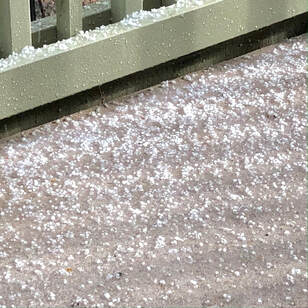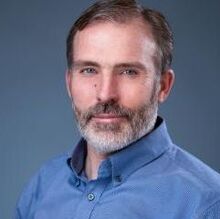 Hail in Mill Valley, Nov. 2020.
Hail in Mill Valley, Nov. 2020.
For many Mill Valley businesses, the use of outdoor space, from outdoor haircuts and manicures to al fresco dining and spin classes, has been paramount to survival. On the Marin Economic Forum‘s monthly Economic Briefing call Monday, MEF Chief Economist Robert Eyler made it clear that getting through the winter – and doing so without incurring another shelter-in-place that could lead to more business closures than we’ve already sustained – is paramount.
That priority became even more important 24 hours later when Marin County Public Health Officer Dr. Matt Willis announced that a due to a recent, short-term (so far) spike in coronavirus cases in Marin, he is recommending that Marin restaurants reduce their indoor dining capacity to 25 percent density, down from the 50 percent density approved on Oct. 27 as part of Marin’s move into the less restrictive orange tier within the statewide Blueprint for a Safer Economy COVID-19 framework. That density reduction also applies to movie theaters (Mill Valley’s CineArts Sequoia remains closed), as well as indoor, faith-based and cultural ceremonies.
 Marin County Public Health Officer Dr. Matt Willis. Courtesy image.
Marin County Public Health Officer Dr. Matt Willis. Courtesy image.
Unlike prior case count spikes that were largely driven by essential workers, the vast majority of whom live in San Rafael’s Canal neighborhood, Willis noted that the recent spike can be traced to white Marin residents participating in indoor gatherings like indoor dining and house parties, where people have longer exposure to one another with less mask usage. Increased mobility – residents traveling within and outside Marin to see family and friends – also drove up case counts, he said.
“Our hope is that we can adjust our policies and practices and avoid having the red tier imposed upon us by the state,” Willis said.
Marin Economic Briefing
 Marin Economic Forum Chief Economist Robert Eyler, at top, and MEF Executive Director Mike Blakeley. Courtesy images.
Marin Economic Forum Chief Economist Robert Eyler, at top, and MEF Executive Director Mike Blakeley. Courtesy images.
Eyler said that while some Marin sectors have fared well in recent months, particularly real estate, banking and finance, service and hospitality businesses continue to get walloped, by high double-digit, year-over-year percentage drops in most cases.
“The travel industry continues to get hammered this year, and that has affected hotels, food services, bar and restaurants – people aren’t traveling and we don’t have as much demand for eating out or going out,” he said. “The hiring continues to be very slow to come back.”
County officials are also grappling with the opaque trend of a sharply reduced local labor force, which has seen 7,600 people leave the Marin labor force since Sept. 2019. “It’s unclear if this is being driven by child care concerns or people just not feeling very good,” Eyler said. “It will take us 12-18 months to sort out that outbound migration. It’s definitely something to watch in terms of available labor.”
“You don’t want to lose the capacity to rebuild incomes and jobs on the other side of the recession,” Eyler said. “If I turned off 55-65 percent of your revenue, it’s very tough to stay in business.”
The biggest question facing Marin in the long term, Eyler said, is whether the sharp downturn for service businesses, from hotels and restaurants to retail and personal services like salons and fitness facilities, will lead to what he dubbed “structural change,” i.e. mass contraction and closures.
“Retail will have a very tough time after the first of the year,” he said.
MEF Executive Director Mike Blakeley closed out the 30-minute briefing with a focus on the road ahead.
“It’s been since beginning of the pandemic that those in lower wage occupations have suffered the most,” he said, noting the more than 20 percent job loss in the personal services sector compared to the 5 percent job loss in professional services. “As Rob mentioned, there are cases where people have been rehired and then lost that job again particularly in lower wage jobs. It raises the question of how you invest in your workforce coming out of a recession. Can we find a way to provide the the training they need to move up the ladder into better paying jobs?”
“If you’re going to achieve resiliency and give people an opportunity to move up, we need to create ways to move up the ladder to more professional services jobs,” Blakeley added.
We also need to come up with backup plans if businesses that were already struggling shut down in the coming months, Blakeley said. “Are we going to make heroic efforts to save them or do we need to consider what other types of business are emerging or growing through the pandemic and how can we find ways to accommodate the new types of business trends that are emerging and enable entrepreneurs that want to start new types of businesses?”
Proposition H
The increased flexibility of Proposition H would allow business and property owners to pivot to new offerings without the prolonged delays that would typically come with seeking new permits. These changes are also designed to make it easier for new businesses to open. The measure requires a streamlined, 30-day review and inspection process for business uses that are already principally permitted in Neighborhood Commercial Districts (NCDs) and Neighborhood Commercial Transit Districts (NCTs).
Prop. H would also: Allow businesses that offer food and drink in NCDs and NCTs to offer workspaces as well; Permit temporary “pop-up” retail activities in vacant commercial storefronts; Allow certain outdoor activity areas on the ground level; Permit temporary uses in certain bars and entertainment venues for up to six years; Allow for certain kinds of restaurant service, such as table service, in parklets; Allow arts activities and social service or philanthropic facilities to operate as principally permitted uses in most NCDs (meaning that they would not have to seek special permission).
And as has been the case since the very beginning of the pandemic, everything will continue to depend on consumer comfort. That is, even if Marin continues to steadily progress through the statewide Blueprint for a Safer Economy COVID-19 framework, the recovery will depend on consumers. “Businesses that rely on people being in indoor spaces are at real risk and we can’t predict when that will get better.”
“There is a very active dialogue among the various chambers of commerce and city managers in Marin about how to help restaurants survive the winter,” Blakeley said. “I expected that we will see some creative solutions.”
You can view the full November 2020 Marin Economic Briefing here:
